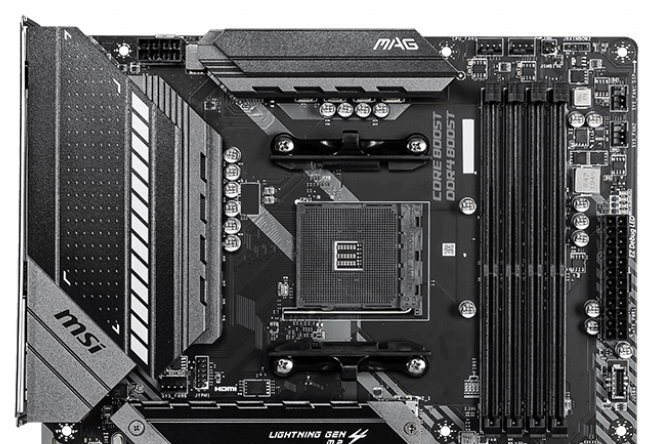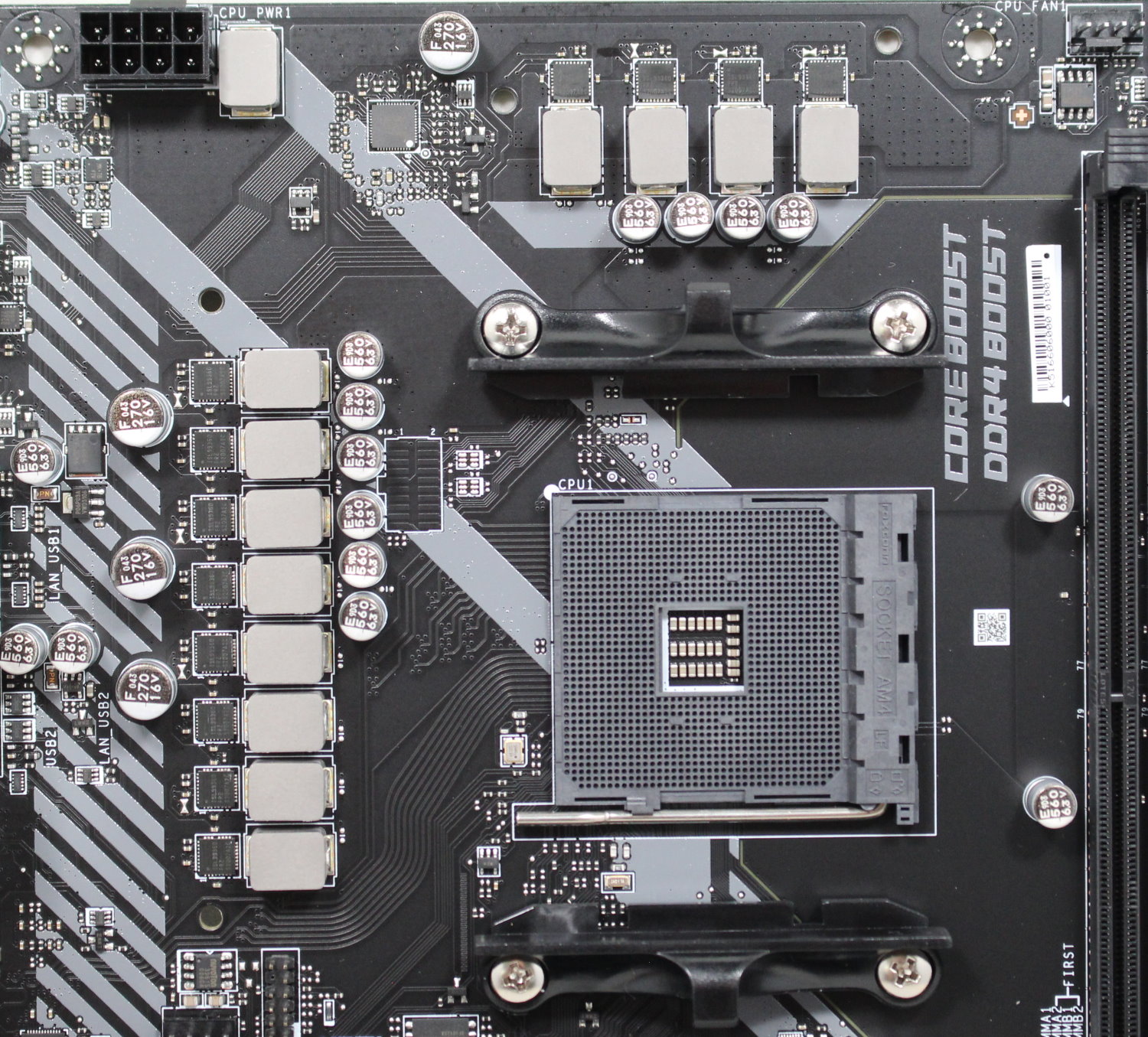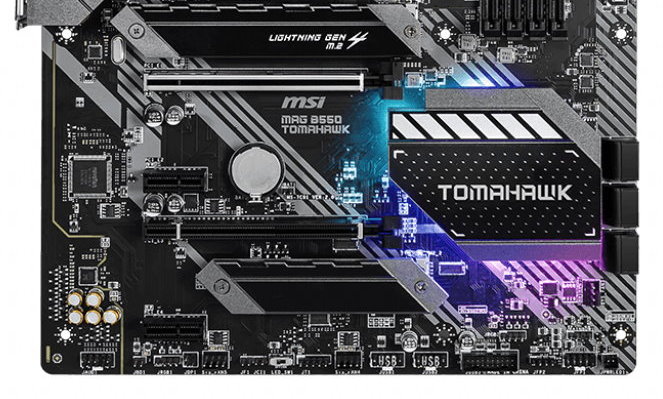Tom's Hardware Verdict
The MSI MAG B550 Tomahawk again delivers a well-balanced feature set at a competitive price. Performance is up there with the more expensive boards, and the VRMs held their own even when overclocked. At $180, you’ll have to live without Wi-Fi and just six USB ports on the rear IO, but otherwise, this is a fully featured and capable option.
Pros
- +
Capable 13-Phase 60A Power Delivery
- +
Dual Ethernet (1/2.5 GbE)
- +
High-power fan/pump headers
Cons
- -
Only six USB ports on Rear IO
- -
Other boards have better audio codec
- -
No integrated Wi-Fi
Why you can trust Tom's Hardware
MSI’s $179.99 MAG Tomahawk has been popular with users in the past thanks to its combo of competitive pricing and a well-balanced feature set. But while the Tomahawk used to be more of a budget entry, the MAG B550 Tomahawk steps up its game to include more premium features like 13-phase power delivery and 2.5Gb Ethernet. Let’s dig into the board and find out if it’s deserving of a spon on our best motherboards list.
MSI’s B550 product stack is similar to the X570 enthusiast lineup in that boards are divided into segments: In order from highest to lowest, B550 uses MPG and MAG for gamers and Pro boards for creators. MSI doesn’t offer its highest-end MEG class boards on the B550 chipset, leaving that segment with X570 on the AMD side. As with the competition, boards come in all sizes from Mini-ITX to ATX with the Gaming Carbon Wi-Fi ($219.99) as the current flagship and the B550M Pro-VDH on the budget side priced at $125.99. The product stack has has lots of variety, but also a top-end price that’s much lower than Asus or Gigabyte B550 boards.
The MAG B550 Tomahawk’s highlights include13-Phase (10+2+1) power delivery, two Ethernet ports (1 GbE and 2.5 GbE), two M.2 slots each, with their own heatsink, oversized VRM heatsinks and more. About the only thing missing is integrated Wi-Fi.
In our testing, the B550 Tomahawk performed well, with results very close to all other B550 boards tested around the platform’s launch. There were no significant outliers in the result, but in general it seems to lean toward the faster side of our recent B550 test group.
With optimized defaults in the BIOS and RAM set to DDR4 3600, the board pushed our Ryzen 9 3900X to its 4.6 GHz boost (two cores) without issue. While overclocked, the board ran the CPU at 4.3 GHz (all cores and threads) along with 4x8GB DDR4 3600 RAM. The Tomahawk behaved well throughout all tests, chopping through the benchmarks with ease.
Specifications
| Socket | AM4 |
|---|---|
| Chipset | B550 |
| Form Factor | ATX |
| Voltage Regulator | 13 Phase (10+2+1) (60A MOSFETs) |
| Video Ports | HDMI, DisplayPort |
| USB Ports | (2) USB 3.2 Gen 2, Type-A and Type-C (10 Gbps), (2) USB 3.2 Gen 1, Type-A (5 Gbps), (2) USB 2.0, Type-A |
| Network Jacks | (1) 2.5 GbE, (1) 1 GbE |
| Audio Jacks | (5) Analog + SPDIF |
| Legacy Ports/Jacks | PS/2 |
| Other Ports/Jack | ✗ |
| PCIe x16 | (1) v4.0 (x16), (1) v3.0 (x4) |
| PCIe x8 | ✗ |
| PCIe x4 | ✗ |
| PCIe x1 | (2) v3.0 (x4) |
| CrossFire/SLI | 2-Way CrossFire |
| DIMM slots | (4) DDR4 5100+(OC), 128GB Capacity |
| M.2 slots | (1) PCIe 4.0 x4 / SATA + PCIe, (1) PCIe 3.0 x4 / PCIe Only |
| U.2 Ports | ✗ |
| SATA Ports | (6) SATA3 6 Gbps |
| USB Headers | (1) USB v3.2 Gen 1, (2) USB v2.0 |
| Fan/Pump Headers | (8) 4-Pin |
| RGB Headers | (2) aRGB (3-pin), (2) RGB (4-pin) |
| Legacy Interfaces | ✗ |
| Other Interfaces | FP-Audio, TPM |
| Diagnostics Panel | Yes (4 LEDs) |
| Internal Button/Switch | LED On/Off |
| SATA Controllers | ✗ |
| Ethernet Controller(s) | Realtek 8125B (2.5 GbE), Realtek 8111H (1 GbE) |
| Wi-Fi / Bluetooth | ✗ |
| USB Controllers | ✗ |
| HD Audio Codec | Realtek ALC1200 |
| DDL/DTS Connect | ✗ / ✗ |
| Warranty | 3 Years |
Features
This accessory stack is sparse, but will get you started. Here’s a list of what ships in the box with the ATX MSI B550 Tomahawk.
- User's manual
- Support DVD
- Quick Install Guide
- Two SATA cables
- Case badge
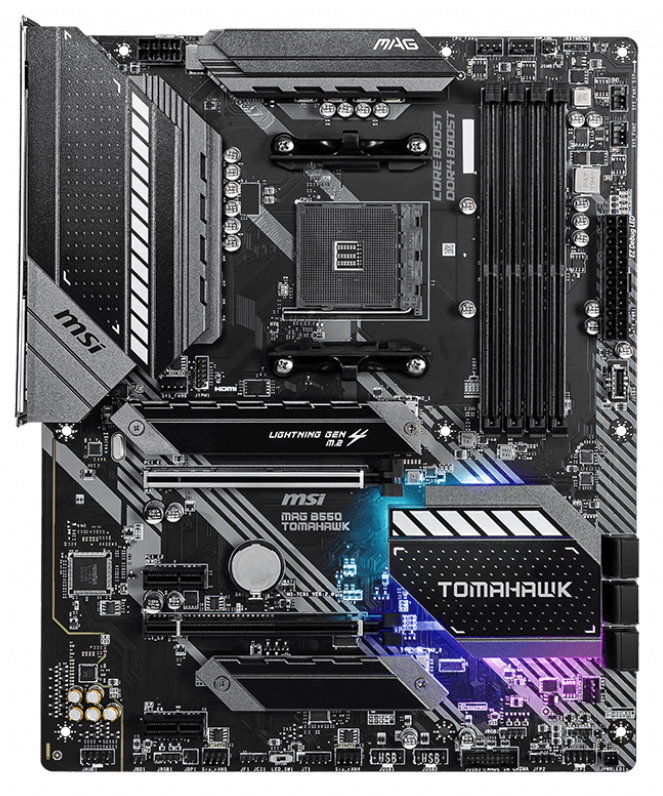
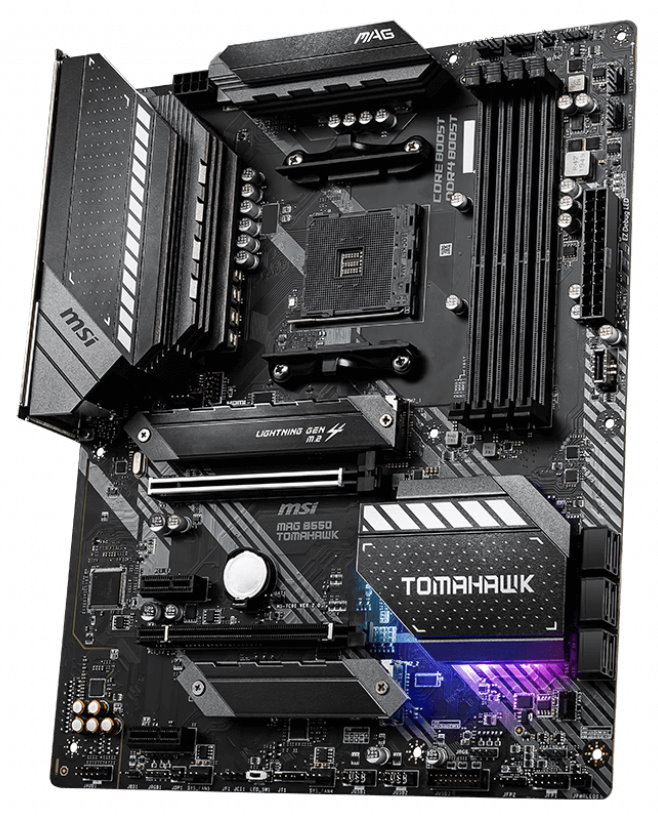
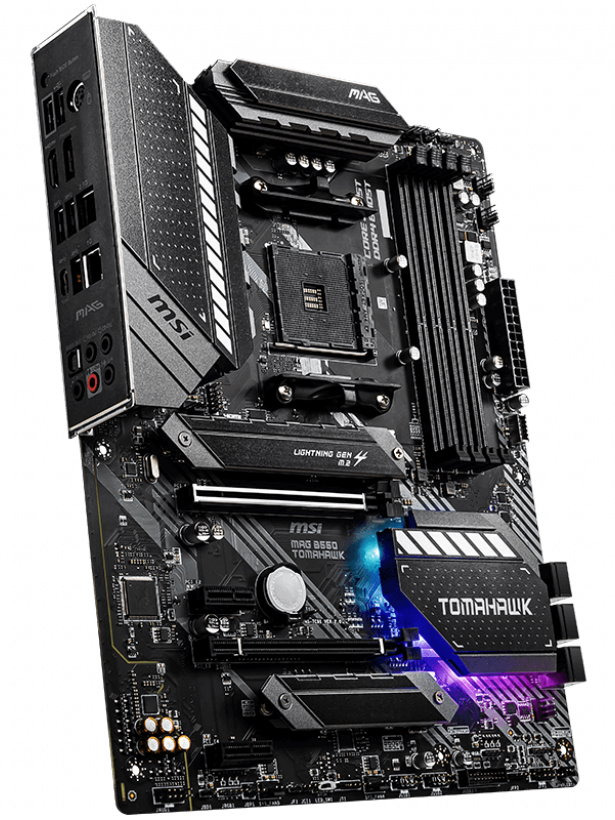
At first glance after taking the B550 Tomahawk out of the box, we see notable differences from B450 and a lot of similarities with the X570 Tomahawk. The PCB is black with the board using grey and black heatsinks, along with grey stenciled lines sweeping diagonally through the motherboard. Outside of that, and the B550 model losing the chipset fan, those boards look remarkably similar. The RGB lighting is housed under the chipset heatsink, illuminating the bottom half of the board with bright saturated colors.
Get Tom's Hardware's best news and in-depth reviews, straight to your inbox.
Zooming in to the top half of the board, the dominant feature is the large VRM heatsink on the left side. Typically, these heatsinks are covered by a shroud, but here, the shroud is actually part of the heatsink. The top VRM bank also has a grey heatsink on it along with the MAG name on top. The board’s black and-and-grey theme will easily blend in to most builds.
Across the top edge to the left of the VRM heatsink is a single 8-pin EPS connector, which is fine for ambient overclocking. Above and to the right of the DIMM slots are four 4-pin PWM/DC fan headers (of eight total). The top two headers, CPU_FAN1 and PUMP_FAN1, are both high powered, listed as 2A/24W and 3A/36W respectively. The latter is one of the highest values I’ve seen on any motherboard.
On the far right edge is a 24-pin ATX connector, along with a front-panel USB 3.2 Gen1 header. Just above the 24-pin power lead is the EZ debug LED, a set of four LEDs labeled Boot, VGA, DRAM and CPU. If there are any issues in these areas, the light that corresponds to the specific POST issue will stay lit, pinpointing where the system is currently stuck. While not as informative as a regular debug LED, this is still very helpful.
Power to the board comes from the single 8-pin, which feeds the 13-phase (10+2+1) digital VRMs. Power is controlled by a Renesas RAA 229004 PWM controller, feeding the mirrored 10-phase CPU/Vcore. Power is then sent to the Intersil ISL99360 MOSFETs that are rated at 60A. This setup is plenty capable of handling our Ryzen 9 3900X at stock and while overclocked.
Moving to the bottom half of the board, we’ll start off on the left side with the audio section. The more expensive boards use the latest Realtek ALC1220 codec (or some variation of) while the Tomahawk uses a Realtek ALC1200, a slightly cut down version of the ALC1220. Unless you are a true audiophile with expensive headsets or speakers, chances are you won’t be able to hear a difference, although it is worth noting the lack of shielding that we usually see on higher-priced boards.
In the middle of the board are two full-length PCIe slots and two x1 sized slots. The primary/top GPU slot is PCIe 4.0 x16 and reinforced, while the bottom slot is PCIe 3.0 x4, with its lanes fed from the chipset. The two x1 slots’ lanes are also sourced from the chipset. The B550 Tomahawk supports 2-Way Crossfire; SLI users need not apply.
The top M.2 socket (M.2_1) supports both SATA- and PCIe-based modules up to 110mm in length. The socket itself receives its bandwidth from the CPU and is PCIe 4.0 x4. The bottom M.2 socket, M.2_2, supports PCIe drives only, with up to four PCIe 3.0 lanes assigned to the device. Note if there are devices in M.2_2 (bottom socket), as well as PCIe_2 and PCIe_4, then PCIe_3 will be unavailable and M.2_2 drops to PCIe 3.0 x2.
On the far right of the board is a stable of six SATA3/6 Gbps ports. These ports are always available, as the lane sharing is done with the M.2 and PCIe slots instead. The SATA ports support RAID 0, 1 and 10 and the NVMe supports RAID 0 and 1.
The bottom edge of the B550 Tomahawk is loaded with headers covering audio, fan control, lighting, USB and more. Below is a list of these headers and jumpers, from left to right.
- Front panel audio
- RGB header
- System fan header
- LED on/off switch
- System fan header
- (2) USB 2.0 headers
- Front-panel USB 3.2 header
- System panel headers
- RGB header
- ARGB header
- System fan header
Like most boards, the rear IO uses an integrated IO shield. We wouldn’t say this board is loaded with connectivity, everything most users are likely to need need is here. You get six USB ports (2x USB 2.0, 2x USB 3.2 Gen1 and 2x USB 3.2 Gen2 ports), HDMI and DisplayPort video outputs for those who are using an APU, dual Ethernet ports and a standard five analog plug plus SPDIF audio stack. The B550 Tomahawk also has a Flash BIOS button for BIOS flash without a CPU, as well as a legacy PS/2 port.

Joe Shields is a staff writer at Tom’s Hardware. He reviews motherboards and PC components.
-
Phaaze88 That's a big jump in price from what used to be reasonably priced on the older B series...Reply
Overclocking is garbage on Ryzen 3000 too; there's a better performance tweak than that.
Ehh, might as well get an Asus TUF Gaming X570 Plus for around the same price... ¯\(ツ)/¯ -
King_V Yeah, I'm not quite sure where $180 became a reasonable price for what was supposed to be a budget chipset, relative to the X570.Reply -
CBOT ReplyThe more expensive boards use the latest Realtek ALC1220 codec (or some variation of) while the Tomahawk uses a Realtek ALC1200, a slightly cut down version of the ALC1220.
I think thats wrong, have the Board running and it says Realtek ALC S1220A. -
Nestea_Zen no fan control? wtf is this the 90s?Reply
but hey, disk cleanup:
c4OpCCPU-D0:165View: https://www.youtube.com/watch?v=c4OpCCPU-D0&t=2m45s
nxKivQwQSew:0View: https://www.youtube.com/watch?v=nxKivQwQSew&t=1m
according to http://download.msi.com/manual/mb/DRAGONCENTER2.pdfthere should be fan control -
jrhansen Many of the B550 boards have considerably more features than the older B450. It is more expensive than what people is used to, but the MSI Tomahawk is a great board with almost the same features as many X570 boards, and more than half of the available X570 boards is actually crappy designed. It seems most board makers have produced some nice B550 boards that is miles better than the X570 counterparts and many of the X570 is just too steep for what they delivers. If AMD had put a PCIe 4.0 uplink to the CPU in the B550 chip it would render 80% of the X570 boards pointless, overpriced and also bad designed for really many off'em. And there is some cheap B550 on the horizon for supposedly under 100 $ so there will be MB for those on a tight budget. But if you are on the really low budget, you could go with a B450 as they won't disapear right away, and those should be sufficient if it is for an ultra budget build anyway.Reply -
SDSI I'm a little perplexed with the 3.5 star rating and this response isn't necessarily criticism of the author's review, but looking at the board of what really matters to the mainstream, which in my opinion doesn't yield a 3.5 star rating.Reply
The only cons were an Audio Realtek codec at 1200, however unless you have very specific needs (most of us don't) there is very little difference in the chips other than 10db increase on the already incredibly efficient 110 db with the ALC1200. By the way, the ALC1200 is a new chip manufactured in 2018 vs. the older 1220. (I hardly this this worth dinging the board for even a half star). If you would like to see the difference please check out this article: ALC1200 vs 1220
Secondly - "lack of Wifi", really? If you are using this board and overclocking for gaming (most would), one wouldn't game using a Wifi connection, but rather use the only board in the round that has 2 ethernet ports sporting 2.5G bandwidth. Further, if it became necessary because of some odd situation where you couldn't be wired one could buy an external usb wifi adapter for: TP-Link USB WiFi Adapter for PC(TL-WN725N), N150 Wireless Network Adapter for Desktop - Nano Size WiFi Dongle Compatible with Windows 10/7/8/8.1/XP/ Mac OS 10.9-10.15 Linux Kernel 2.6.18-4.4.3 at Amazon for $7.99US dollars. Again, hardly worth a half a star ding.
Further, only 6 rear usb ports - I don't see the issue here as most enthusiasts utilize ports rear and in front which by the way has 7 ports for a total of 13. I suspect that number on the rear is due to the very useful dual ethernet ports supporting 2.5Gbs of bandwidth which the other motherboards as comparison don't offer. And with the above statement being repeated, this hardly qualifies for even a half star ding.
Lastly, the benchmarks were spot-on noting in several cases this board outperforming the other boards in the round up. The author spends very little time in this area. I giving the overall performance/price to, you guessed it, the MSI board. Most notably this board has almost all the" big boy" features the other two in the review have as well as features those boards don't sport at a current price of $179.00 US dollars vs. the Gigabyte B550 Aorus Master +35% more @ ($279.99) and the Asus ROG Strix B550-F Gaming Wifi +14% more @ ($209.99).
In conclusion - what is not to like about the board? Not much if anything. Frankly if you must ding the board from a 5 star rating for boring looks - I guess that is ok.
My conclusion:
Value: 5 Stars (I'm really stretching (Really could be a 4.5), however it is a better value than the competition in the review so it receives a 5 star rating.
Performance: 4.5 Stars (maybe a couple of features hard core overclockers don't have at their disposal - can you say $179.99?
Features: 5 Stars (built in wireless and a newer more efficient AC1200 (2018)that suffers -10 decibal difference from its older big brother at 1220 (2017) hardly fall into mainstream features that really matter to the masses.)
Verdict 4.8 stars.
Ryan
